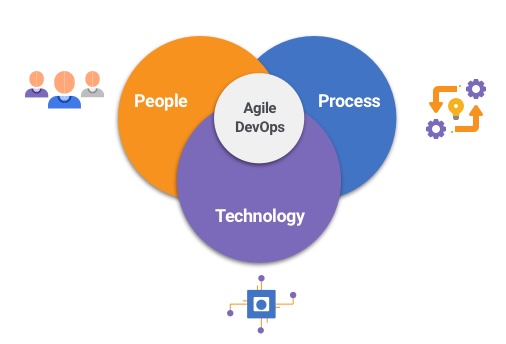By ATS Staff - March 28th, 2025
Agile Software Development Software Testing
In today's fast-paced digital landscape, organizations are constantly striving to deliver high-quality software faster than ever before. Agile and DevOps, when combined, offer a powerful approach to achieve this goal. However, simply adopting these methodologies isn't enough. Success hinges on implementing a set of best practices that foster collaboration, automation, and continuous improvement.
1. Cultivate a Culture of Collaboration and Communication:
* Break Down Silos: The traditional divide between development and operations teams must be eliminated. Cross-functional teams, where developers, operations engineers, and testers work together, are essential.
* Embrace Shared Ownership: Everyone is responsible for the entire software lifecycle, from development to deployment and maintenance.
* Foster Open Communication: Regular stand-up meetings, retrospectives, and knowledge-sharing sessions facilitate effective communication and alignment.
* Utilize Collaboration Tools: Tools like Slack, Microsoft Teams, and Jira can streamline communication and track progress.
2. Automate Everything Possible:
* Continuous Integration/Continuous Delivery (CI/CD): Automate the build, test, and deployment processes to reduce manual errors and accelerate release cycles.
* Infrastructure as Code (IaC): Manage infrastructure using code, enabling consistent and repeatable deployments. Tools like Terraform and CloudFormation are crucial.
* Automated Testing: Implement comprehensive automated testing at all stages of the software development lifecycle, including unit, integration, and end-to-end testing.
* Configuration Management: Use tools like Ansible, Chef, or Puppet to automate server configuration and management.
3. Embrace Continuous Feedback and Improvement:
* Frequent Releases: Smaller, more frequent releases allow for faster feedback loops and quicker responses to customer needs.
* Monitoring and Logging: Implement robust monitoring and logging systems to track application performance and identify potential issues. Tools like Prometheus, Grafana, and ELK stack are essential.
* Feedback Loops: Establish mechanisms for gathering feedback from users, stakeholders, and team members.
* Retrospectives: Conduct regular retrospectives to identify areas for improvement and implement changes.
* A/B Testing and Canary Releases: Use these Techniques to validate changes in production with a small subset of users before wider deployment.
4. Focus on Small, Iterative Changes:
* Break Down Large Tasks: Divide large projects into smaller, manageable tasks that can be completed in short iterations.
* Minimum Viable Product (MVP): Focus on delivering an MVP with core functionality and iterate based on user feedback.
* Agile Methodologies: Employ Agile methodologies like Scrum or Kanban to manage the development process and ensure flexibility.
5. Prioritize Security Throughout the Lifecycle (DevSecOps):
* Shift Left Security: Integrate security into the early stages of the development process, rather than treating it as an afterthought.
* Automated Security Testing: Implement automated security testing tools to identify vulnerabilities early.
* Security as Code: Manage security configurations using code, ensuring consistency and repeatability.
* Continuous Monitoring: Continuously monitor systems for security threats and respond quickly to incidents.
* Policy as Code: Implement and automate security policies as code to ensure compliance.
6. Invest in Skills and Training:
* Cross-Training: Encourage team members to learn new skills and expand their knowledge across different areas.
* Continuous Learning: Foster a culture of continuous learning and provide opportunities for professional development.
* Tooling Expertise: Ensure team members are proficient in the tools and technologies used in the Agile DevOps pipeline.
7. Measure and Optimize:
* Key Performance Indicators (KPIs): Define and track KPIs to measure the effectiveness of the Agile DevOps practices. Common KPIs include deployment frequency, lead time, mean time to recovery (MTTR), and change failure rate.
* Data-Driven Decisions: Use data and analytics to identify bottlenecks and areas for improvement.
* Regular Optimization: Continuously optimize the Agile DevOps pipeline based on data and feedback.
By implementing these best practices, organizations can achieve significant improvements in software delivery speed, quality, and reliability. Agile DevOps is not a one-size-fits-all solution, and organizations must adapt these practices to their specific needs and context. However, the core principles of collaboration, automation, and continuous improvement remain essential for success in the ever-evolving world of software development.
Popular Categories
Agile 2 Android 2 Artificial Intelligence 49 Blockchain 2 Cloud Storage 3 Code Editors 2 Computer Languages 11 Cybersecurity 8 Data Science 14 Database 5 Digital Marketing 3 Ecommerce 3 Email Server 2 Finance 2 Google 6 HTML-CSS 2 Industries 6 Infrastructure 2 iOS 3 Javascript 5 Latest Technologies 41 Linux 5 LLMs 11 Machine Learning 32 Mobile 3 MySQL 2 Operating Systems 3 PHP 2 Project Management 3 Python Programming 25 SEO - AEO 5 Software Development 43 Software Testing 3 Web Server 6 Work Ethics 2